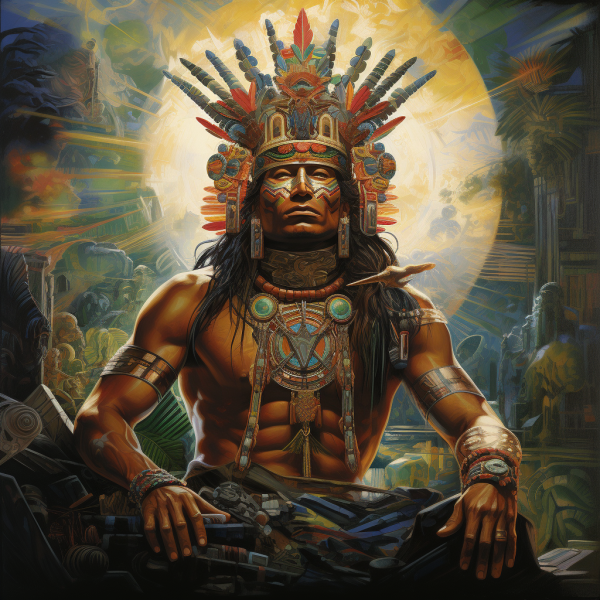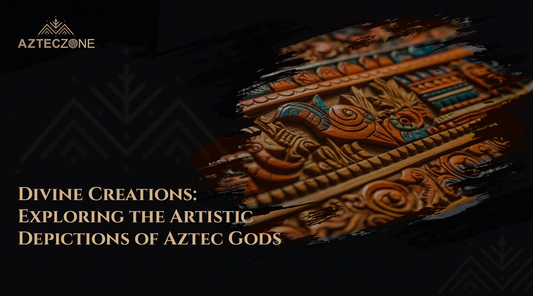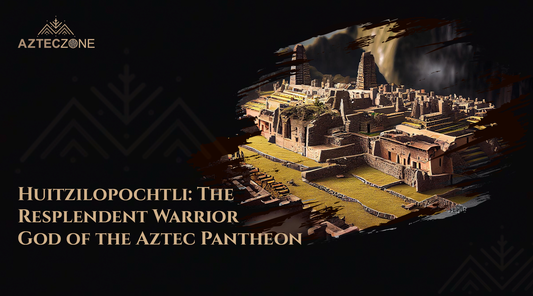The Role of Tlatoani: Understanding the Leadership and Power of Aztec Rulers
In the grand tapestry of Aztec civilization, the Tlatoani emerged as pivotal figures, wielding immense power and authority. These noble rulers held the highest office in the Aztec political system, governing the vast empire with a blend of military prowess, diplomacy, and divine legitimacy. As paramount leaders, the Tlatoani played a crucial role in shaping the Aztec society, economy, and religious practices. In this article, we delve into the rich history of the Tlatoani, shedding light on their responsibilities, rituals, and the influence they wielded over the lives of their subjects.
The Rise of the Tlatoani
The emergence of the Tlatoani dates back to the early stages of Aztec civilization when several city-states dotted the Valley of Mexico. These city-states were often in conflict with one another, and to maintain stability, they elected military leaders known as Tlatoque, signifying speakers or rulers. Over time, one of these leaders, Acamapichtli, managed to unify various city-states under the Aztec banner and became the first Aztec Tlatoani in 1376. This marked the beginning of a dynasty that would see several illustrious rulers ascend to the throne.
The Tlatoani's Seat of Power
The Tlatoani's residence and seat of power, known as the "huey tlatoani," was an impressive structure located in the heart of the capital city, Tenochtitlan. The grandeur of the palace was a testament to the Tlatoani's authority and was adorned with intricate murals and sculptures, depicting Aztec myths, battles, and religious practices. The palace served as both the political center and the sacred space where important rituals and ceremonies took place.
Responsibilities of the Tlatoani
As the highest authority in the land, the Tlatoani's responsibilities were extensive and multi-faceted. They were not only the military commanders and administrators but also the highest priests, ensuring that the Aztec religious ceremonies were performed with precision and reverence. Additionally, the Tlatoani had the onerous task of maintaining alliances with neighboring city-states, overseeing trade, and addressing any internal conflicts within the empire.
Divine Legitimacy and Rituals
The Tlatoani's rule was often believed to be divinely sanctioned. Aztecs held the firm belief that their rulers were descendants of the gods, especially Huitzilopochtli, the Aztec god of war and the sun. To maintain this divine connection, the Tlatoani actively participated in religious rituals, including human sacrifices, which they believed were essential to appease the gods and ensure the prosperity of the empire.
Tlatoani Succession and Challenges
The Tlatoani's reign was not without challenges. Succession to the throne was not automatically passed from father to son; rather, the nobility and high-ranking officials played a significant role in selecting the next Tlatoani. This often led to political intrigue and even conflicts within the ruling elite. Moreover, external threats from neighboring civilizations posed constant challenges to the Tlatoani's authority and their ability to maintain control over the empire.
The Tlatoani, as Aztec rulers, stood at the apex of a complex and vibrant civilization. Their leadership shaped the destiny of the Aztec people and left an enduring legacy that continues to captivate historians and enthusiasts alike. Understanding the pivotal role of the Tlatoani provides invaluable insights into the political, religious, and social dynamics of the Aztec Empire, offering a glimpse into the rich tapestry of this ancient civilization.
The Tlatoani's Seat of Power
The Tlatoani's residence, also known as the "huey tlatoani," was the centerpiece of Aztec political power and authority. Situated in the heart of the majestic capital city, Tenochtitlan, the palace was a remarkable architectural marvel that showcased the grandeur and opulence befitting the highest ruler of the Aztec Empire. The seat of power was not only a political center but also a sacred space where important rituals and ceremonies took place, further cementing the Tlatoani's divine legitimacy.
Architecture and Design
The Tlatoani's palace was an awe-inspiring structure that blended artistic finesse with engineering brilliance. Constructed using stone and adobe bricks, the palace featured intricate carvings, elaborate murals, and colorful frescoes that depicted the rich mythology, religious practices, and historical events of the Aztecs. The architecture followed a symmetrical layout with courtyards, chambers, and ceremonial spaces adorned with symbolic representations of Aztec cosmology and beliefs.
Ceremonial Spaces
Within the palace, specific areas were dedicated to the performance of religious ceremonies and rituals. The Tlatoani played a central role in these ceremonies, acting as the intermediary between the mortal world and the divine realm. One of the most significant rituals performed by the Tlatoani was the "Binding of the Years," which marked the end of a 52-year cycle in the Aztec calendar. This ritual involved elaborate offerings and sacrifices to ensure the renewal of the cosmic order and the continuation of the universe.
Symbolism and Artistry
Every aspect of the Tlatoani's palace was infused with deep symbolism and artistry. The murals and carvings showcased the Tlatoani's divine connection to the gods, depicting them in various ritualistic poses and adorned with sacred regalia. The walls of the palace told the stories of the Aztec gods and their triumphs, illustrating the Tlatoani's role as both a political leader and a religious figure.
Administrative Center
Beyond its religious significance, the Tlatoani's palace served as the administrative hub of the empire. High-ranking officials, nobility, and advisors gathered in the palace to discuss matters of governance, trade, and foreign relations. The Tlatoani held audiences with ambassadors from neighboring city-states, and the palace became a melting pot of cultures and traditions, showcasing the grandeur and sophistication of the Aztec Empire.
Legacy and Destruction
The Tlatoani's palace was a testament to the Aztec's architectural prowess and cultural achievements. Sadly, after the fall of the Aztec Empire in 1521, the Spanish conquistadors razed the once-magnificent capital city, including the Tlatoani's palace. Much of the Aztec architecture and artistry were lost, and the remnants of this majestic seat of power were buried beneath the ruins.
The Tlatoani's palace, also known as the "huey tlatoani," was a magnificent testament to the Aztec's architectural and artistic achievements. As the political and religious heart of the empire, the palace served as a symbol of the Tlatoani's divine connection to the gods and their role as the highest ruler of the Aztec civilization. Though lost to history, the legacy of the Tlatoani's palace continues to captivate our imagination, offering a glimpse into the grandeur and complexity of the Aztec Empire.
The Tlatoani's Leadership and Responsibilities
The Tlatoani, as the supreme ruler of the Aztec Empire, held immense power and authority over all aspects of the society. Their role was not only political but also deeply intertwined with religious and ceremonial duties. The responsibilities of the Tlatoani encompassed maintaining social order, overseeing economic affairs, leading military campaigns, and acting as the spiritual intermediary between the people and the gods. Their leadership was crucial in shaping the empire's destiny and ensuring its prosperity.
The Tlatoani was the ultimate political leader, responsible for governing the empire's vast territories and managing the city-states under Aztec control. They presided over councils of nobles and advisors, making important decisions regarding trade, law, and public policy. The Tlatoani's decisions were guided by the principles of justice and welfare for their subjects.
In addition to their political duties, the Tlatoani played a pivotal role in managing the empire's economy. They oversaw the collection of tributes from subject cities, ensuring a steady flow of resources and wealth into the capital. The Tlatoani's administration also facilitated trade networks and encouraged the development of specialized crafts and industries, contributing to the empire's economic prosperity.
In times of war, the Tlatoani assumed the role of the supreme military commander. They led armies into battle, strategized military campaigns, and inspired their warriors to fight courageously in defense of the empire. The Tlatoani's military prowess and leadership were essential in protecting the Aztec territories and expanding the empire's borders.
The Tlatoani held an exalted religious position, acting as the high priest and mediator between the mortal world and the gods. They performed elaborate rituals and sacrifices to appease the deities and ensure the prosperity of the empire. The Tlatoani's religious duties were intertwined with their political authority, reinforcing their divine legitimacy as rulers.
The Tlatoani participated in various religious ceremonies and festivals throughout the year. One of the most important events was the New Fire Ceremony, performed at the end of the 52-year calendar cycle to renew the cosmic order. The Tlatoani's participation in these rituals was essential to maintain the harmony between the celestial and earthly realms.
The Tlatoani's rule was passed down through a hereditary system within the royal family. Upon the death of the Tlatoani, a new ruler from the royal lineage would ascend to the throne. The Tlatoani's legacy was evaluated based on their ability to maintain social order, protect the empire, and ensure the well-being of their subjects.
The Tlatoani's leadership and responsibilities were multifaceted, encompassing political, economic, military, and religious aspects. Their role as the supreme ruler of the Aztec Empire was defined by their divine connection to the gods and their commitment to the welfare and prosperity of their people. The Tlatoani's legacy continues to be celebrated in the annals of Aztec history, standing as a testament to their vision, wisdom, and dedication to their empire and its people.
The Tlatoani's Symbolic Representations and Regalia
The Tlatoani, as the highest authority in the Aztec Empire, adorned themselves with rich regalia and symbols that reflected their elevated status and divine connection. These representations served to solidify their legitimacy and divine right to rule. The Tlatoani's regalia and symbols were essential in conveying their authority and reinforcing their position as the chosen leader of the Aztec people.
One of the most distinctive symbols of the Tlatoani was the "xiuhuitzolli," a headdress adorned with quetzal feathers. Quetzal birds were considered sacred creatures, and their vibrant green feathers symbolized life, fertility, and divine connection. The xiuhuitzolli was a prominent visual representation of the Tlatoani's divine authority and connection to the gods.
Another significant symbol of the Tlatoani was the "tecpatl," a ceremonial obsidian knife. This knife was not used for mundane purposes but instead played a central role in ritual sacrifices performed by the Tlatoani. As the high priest, the Tlatoani conducted religious ceremonies and made offerings to the gods, ensuring the well-being of the empire and its people. The tecpatl symbolized the Tlatoani's role as a spiritual leader and mediator between the mortal world and the divine.
The Tlatoani also wore an elaborate cloak known as the "tilmatli," made from fine cotton and adorned with intricate designs and symbols. The tilmatli was a regal garment worn during important ceremonies and official events, further emphasizing the Tlatoani's authority and status.
In addition to their regalia, the Tlatoani's appearance was enhanced by body paint and elaborate tattoos. These markings held deep symbolic meanings, representing their connection to specific gods, celestial events, or heroic ancestors. The body paint and tattoos were not only ornamental but also served as a visual testament to the Tlatoani's divine lineage and divine favor.
The Tlatoani's regalia was also displayed in their residences and palaces, which were adorned with intricate carvings, murals, and sculptures depicting scenes of conquest, religious ceremonies, and divine beings. These grand architectural structures served as visual representations of the Tlatoani's power and their role in upholding the cosmic order.
Throughout their reign, the Tlatoani would receive symbolic offerings and tribute from their subjects as a gesture of loyalty and reverence. These offerings ranged from precious metals and gemstones to agricultural products and handicrafts. The presentation of tribute reinforced the Tlatoani's authority and acted as a symbol of the empire's unity under their leadership.
The Tlatoani's symbolic representations and regalia played a crucial role in solidifying their authority as the supreme ruler of the Aztec Empire. Through distinctive headdresses, ceremonial knives, ornate cloaks, and symbolic body paint, the Tlatoani visually conveyed their divine connection and legitimacy as leaders chosen by the gods. The grand architectural structures and symbolic offerings further reinforced their position as the central figure in maintaining the Aztec world order and guiding their empire to prosperity and greatness.
The Tlatoani's Role in Aztec Society and Governance
The Tlatoani held a position of immense significance in Aztec society, acting as the highest political, religious, and military authority. Their role extended beyond ceremonial duties, encompassing various responsibilities that shaped the empire's governance and ensured its smooth functioning. Understanding the Tlatoani's multifaceted role is crucial to grasping the dynamics of Aztec society and the complexities of their leadership.
The Tlatoani served as the supreme political leader of the Aztec Empire. They held absolute power and exercised authority over every aspect of governance, ranging from law enforcement to the administration of justice. The Tlatoani's decisions were final and binding, and they presided over council meetings where important matters concerning the empire were discussed.
Additionally, the Tlatoani was not only a political leader but also the high priest of the Aztec religion. They were responsible for overseeing religious ceremonies, offering sacrifices to the gods, and maintaining harmony between the mortal realm and the divine. The Tlatoani played a central role in ensuring the favor of the gods, which was believed to be crucial for the empire's prosperity and success.
As the commander-in-chief of the Aztec military, the Tlatoani held significant control over the empire's armed forces. They were responsible for strategizing military campaigns, planning conquests, and defending the empire from external threats. The Tlatoani's military prowess was essential in expanding the empire's territories and maintaining its dominance over neighboring regions.
Moreover, the Tlatoani oversaw the collection of tribute from subject provinces and redistributed resources and goods within the empire. Tribute, in the form of valuable commodities, agricultural products, and handicrafts, was essential for sustaining the empire's economy and supporting the ruling elite.
The Tlatoani also engaged in diplomatic relations with neighboring city-states and empires, negotiating treaties, and forming alliances. Maintaining diplomatic ties was vital in ensuring peaceful coexistence and expanding trade networks, which contributed to the empire's economic prosperity.
Additionally, the Tlatoani played a role in overseeing the construction of grand architectural projects, such as temples, palaces, and aqueducts. These infrastructures not only showcased the Tlatoani's wealth and power but also contributed to the well-being and quality of life of the Aztec people.
Furthermore, the Tlatoani participated in numerous religious and ceremonial events, symbolizing their divine connection and role as the intermediary between the gods and the people. These ceremonies reinforced the empire's religious beliefs and traditions and strengthened the Tlatoani's position as the spiritual leader of the Aztec people.
The Tlatoani's multifaceted role in Aztec society exemplified their importance as both political and religious figures. Their authority was absolute, and they held immense responsibilities in shaping the empire's destiny. Understanding the Tlatoani's governance and leadership is crucial for comprehending the complexities of the Aztec civilization and appreciating the enduring legacy of their rule.




